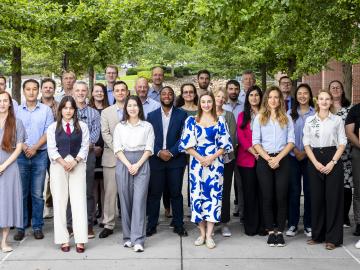
Filter News
Area of Research
- (-) Fusion and Fission (55)
- (-) Materials (433)
- (-) National Security (81)
- (-) Nuclear Science and Technology (74)
- Advanced Manufacturing (34)
- Biological Systems (18)
- Biology and Environment (177)
- Biology and Soft Matter (5)
- Building Technologies (12)
- Chemical and Engineering Materials (4)
- Chemistry and Physics at Interfaces (11)
- Clean Energy (525)
- Climate and Environmental Systems (14)
- Computational Biology (6)
- Computational Chemistry (5)
- Computational Engineering (5)
- Computer Science (19)
- Data (1)
- Earth Sciences (1)
- Electricity and Smart Grid (3)
- Energy Frontier Research Centers (14)
- Energy Sciences (5)
- Fossil Energy (3)
- Fuel Cycle Science and Technology (3)
- Functional Materials for Energy (16)
- Fusion Energy (19)
- Geographic Information Science and Technology (3)
- Isotope Development and Production (3)
- Isotopes (36)
- Materials Characterization (2)
- Materials for Computing (36)
- Materials Synthesis from Atoms to Systems (13)
- Materials Under Extremes (12)
- Mathematics (1)
- Neutron Data Analysis and Visualization (4)
- Neutron Science (191)
- Nuclear Systems Modeling, Simulation and Validation (3)
- Nuclear Systems Technology (1)
- Quantum Condensed Matter (4)
- Quantum information Science (9)
- Reactor Technology (1)
- Renewable Energy (4)
- Sensors and Controls (5)
- Supercomputing (312)
- Transportation Systems (11)
News Type
News Topics
- 3-D Printing/Advanced Manufacturing (31)
- Advanced Reactors (21)
- Artificial Intelligence (22)
- Big Data (7)
- Bioenergy (15)
- Biology (9)
- Biomedical (10)
- Biotechnology (1)
- Buildings (6)
- Chemical Sciences (34)
- Clean Water (3)
- Climate Change (9)
- Composites (9)
- Computer Science (37)
- Coronavirus (7)
- Critical Materials (13)
- Cybersecurity (21)
- Decarbonization (12)
- Education (1)
- Energy Storage (36)
- Environment (23)
- Exascale Computing (3)
- Fossil Energy (1)
- Frontier (4)
- Fusion (36)
- Grid (12)
- High-Performance Computing (10)
- Irradiation (1)
- Isotopes (17)
- ITER (6)
- Machine Learning (16)
- Materials (75)
- Materials Science (81)
- Mathematics (1)
- Microscopy (27)
- Molten Salt (7)
- Nanotechnology (39)
- National Security (35)
- Net Zero (2)
- Neutron Science (41)
- Nuclear Energy (78)
- Partnerships (17)
- Physics (32)
- Polymers (17)
- Quantum Computing (3)
- Quantum Science (12)
- Renewable Energy (1)
- Security (13)
- Simulation (5)
- Space Exploration (8)
- Summit (4)
- Sustainable Energy (21)
- Transformational Challenge Reactor (5)
- Transportation (18)
Media Contacts

Three flights, five thousand miles and half a dozen clearances and permissions stood between Tetiana Maltseva and the Department of Energy’s Oak Ridge National Laboratory. When she finally arrived at the lab to represent Ukraine at the 2024 Nuclear Energy Management School, her vision was clear.

On Feb. 15, 2024, the one billionth item, also known as an “occupancy,” was scanned at the Port of Aqaba, Jordan, one of the early sites where radiation detection equipment was installed. This milestone shows the extent of countries committed to preventing the spread of radioactive material through the amount of data volunteered to ORNL for continuous improvement. As adversaries push the limits of smuggling dangerous material, this collaboration pushes back through science-backed analysis.

The National Security Sciences Directorate within the Department of Energy’s Oak Ridge National Laboratory has signed a memoranda of understanding with Jackson State University and with Tennessee Tech University. The MOUs detail ORNL’s intention to work with each university to enhance research and educational opportunities in nuclear science and engineering.
ORNL drone and geospatial team becomes first to map the Coca River in the Amazon basin as erosion and sediment threaten Ecuador’s lands.

A collection of seven technologies for lithium recovery developed by scientists from ORNL has been licensed to Element3, a Texas-based company focused on extracting lithium from wastewater produced by oil and gas production.

Three staff members in ORNL’s Fusion and Fission Energy and Science Directorate have moved into newly established roles facilitating communication and program management with sponsors of the directorate’s Nuclear Energy and Fuel Cycle Division.

Electric vehicles can drive longer distances if their lithium-ion batteries deliver more energy in a lighter package. A prime weight-loss candidate is the current collector, a component that often adds 10% to the weight of a battery cell without contributing energy.

Jack Orebaugh, a forensic anthropology major at the University of Tennessee, Knoxville, has a big heart for families with missing loved ones. When someone disappears in an area of dense vegetation, search and recovery efforts can be difficult, especially when a missing person’s last location is unknown. Recognizing the agony of not knowing what happened to a family or friend, Orebaugh decided to use his internship at the Department of Energy’s Oak Ridge National Laboratory to find better ways to search for lost and deceased people using cameras and drones.

Two fusion energy leaders have joined ORNL in the Fusion and Fission Energy and Science Directorate, or FFESD.



